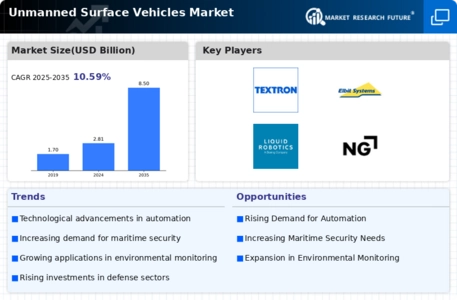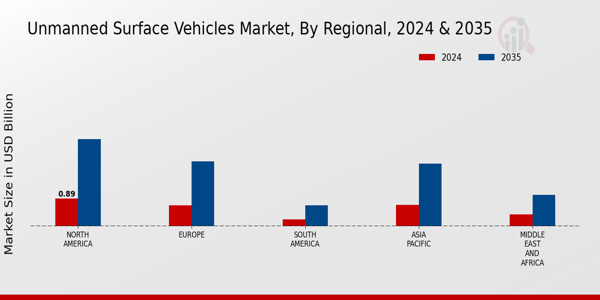Commercial Applications
The commercial sector is emerging as a significant driver for the Global Unmanned Surface Vehicles Market Industry. Industries such as shipping, oil and gas, and fisheries are increasingly adopting unmanned surface vehicles for various applications, including cargo transport, underwater inspections, and resource exploration. The efficiency and cost-effectiveness of these vehicles are appealing to businesses looking to optimize operations. As the market evolves, the integration of unmanned systems into commercial activities is expected to grow, contributing to the projected increase from 2.81 USD Billion in 2024 to 8.5 USD Billion by 2035. This trend highlights the versatility and potential of unmanned surface vehicles in diverse sectors.
Market Growth Projections
The Global Unmanned Surface Vehicles Market Industry is projected to experience substantial growth over the next decade. With an estimated market value of 2.81 USD Billion in 2024, it is anticipated to reach 8.5 USD Billion by 2035, reflecting a compound annual growth rate of 10.59% from 2025 to 2035. This growth trajectory suggests a robust demand for unmanned surface vehicles across various sectors, including defense, commercial, and environmental applications. The increasing adoption of advanced technologies and the expansion of operational capabilities are likely to contribute to this upward trend, positioning the market for significant advancements in the coming years.
Increased Defense Spending
Rising defense budgets across various nations are significantly driving the Global Unmanned Surface Vehicles Market Industry. Governments are increasingly investing in unmanned systems to enhance maritime security and surveillance capabilities. For example, countries like the United States and China are allocating substantial resources to develop and deploy advanced unmanned surface vehicles for naval operations. This trend is expected to bolster market growth, as defense agencies seek to modernize their fleets with cutting-edge technology. The anticipated growth from 2.81 USD Billion in 2024 to 8.5 USD Billion by 2035 reflects the strategic importance of unmanned systems in national defense.
Technological Advancements
The Global Unmanned Surface Vehicles Market Industry is experiencing rapid technological advancements, particularly in autonomous navigation and communication systems. Innovations such as artificial intelligence and machine learning are enhancing the operational efficiency and decision-making capabilities of these vehicles. For instance, the integration of advanced sensors and real-time data processing allows for improved situational awareness and mission execution. As a result, the market is projected to grow from 2.81 USD Billion in 2024 to 8.5 USD Billion by 2035, with a compound annual growth rate of 10.59% from 2025 to 2035. This trend indicates a strong demand for sophisticated unmanned systems across various sectors.
Regulatory Support and Initiatives
Regulatory frameworks and government initiatives are playing a crucial role in shaping the Global Unmanned Surface Vehicles Market Industry. Many countries are establishing guidelines and policies to facilitate the safe integration of unmanned systems into national waters. This regulatory support fosters innovation and encourages investment in unmanned technologies. For instance, initiatives aimed at promoting research and development in unmanned systems are likely to enhance market growth. The expected rise from 2.81 USD Billion in 2024 to 8.5 USD Billion by 2035 indicates a favorable environment for the proliferation of unmanned surface vehicles, driven by supportive regulations.
Environmental Monitoring and Research
The Global Unmanned Surface Vehicles Market Industry is also being propelled by the growing need for environmental monitoring and research. Unmanned surface vehicles are increasingly utilized for oceanographic studies, pollution monitoring, and marine ecosystem assessments. Their ability to operate in challenging environments without risking human life makes them invaluable for scientific research. For instance, these vehicles can collect data on water quality and marine biodiversity, contributing to global efforts in climate change research. The market's expansion from 2.81 USD Billion in 2024 to 8.5 USD Billion by 2035 underscores the rising demand for unmanned systems in environmental applications.















